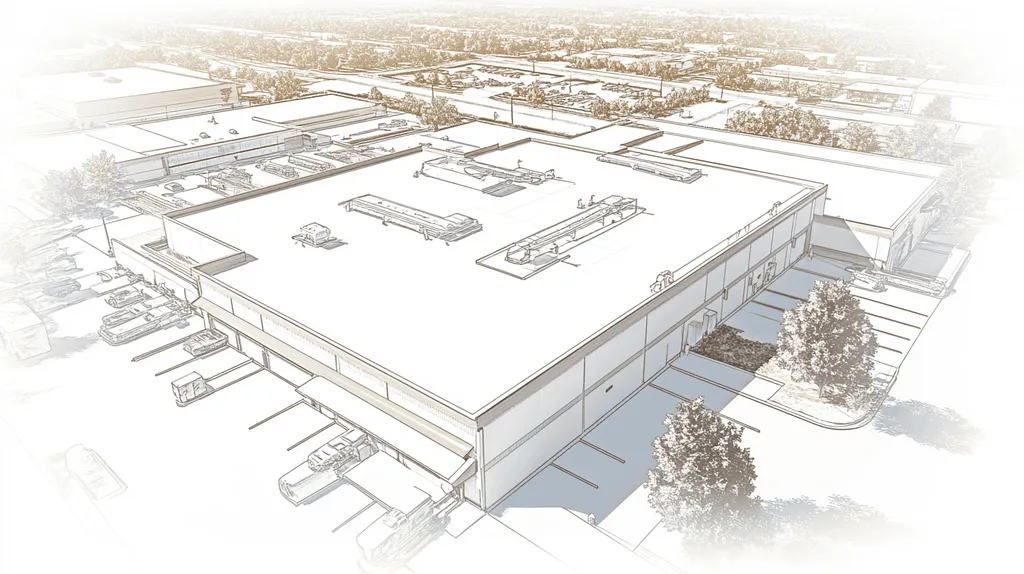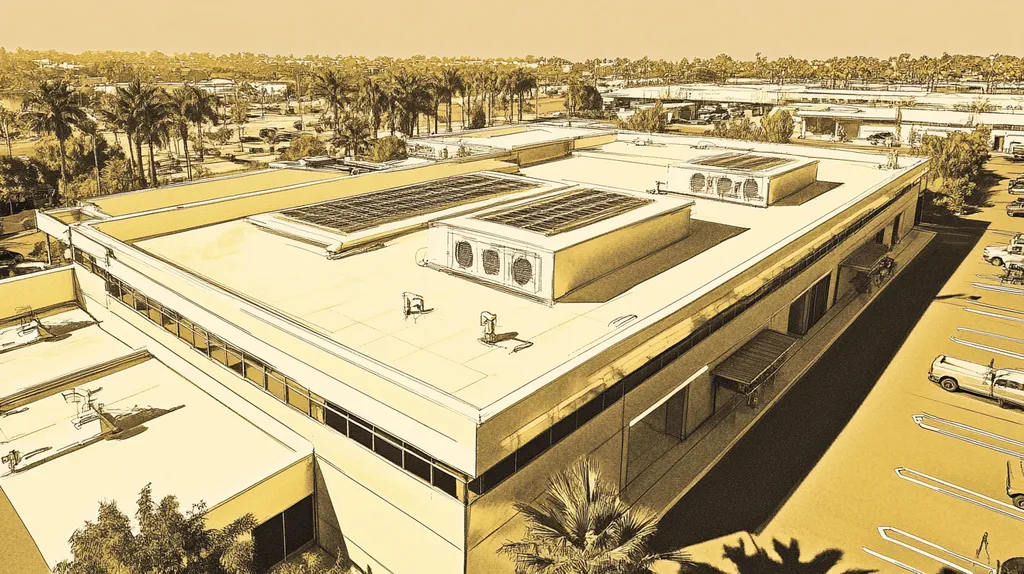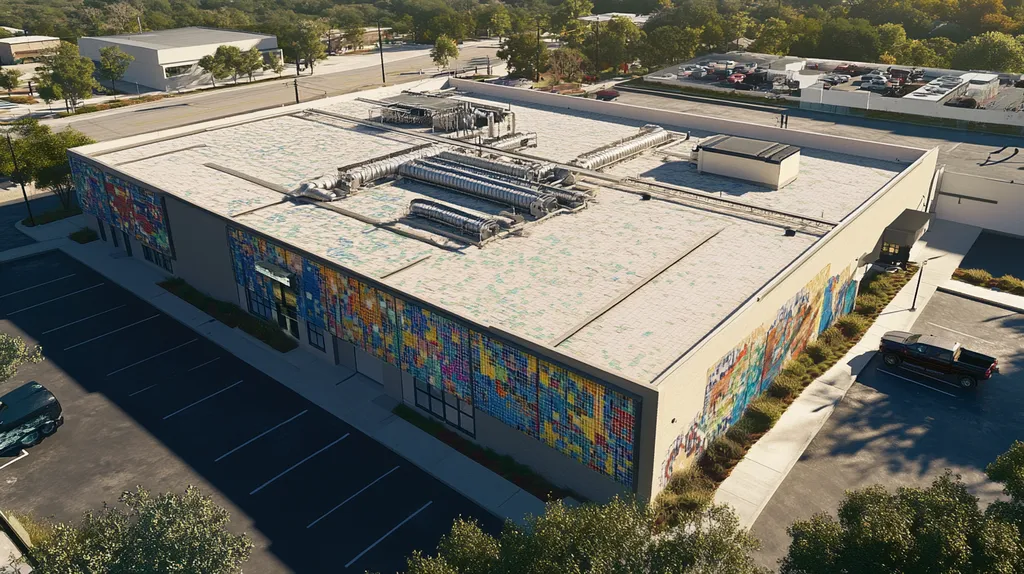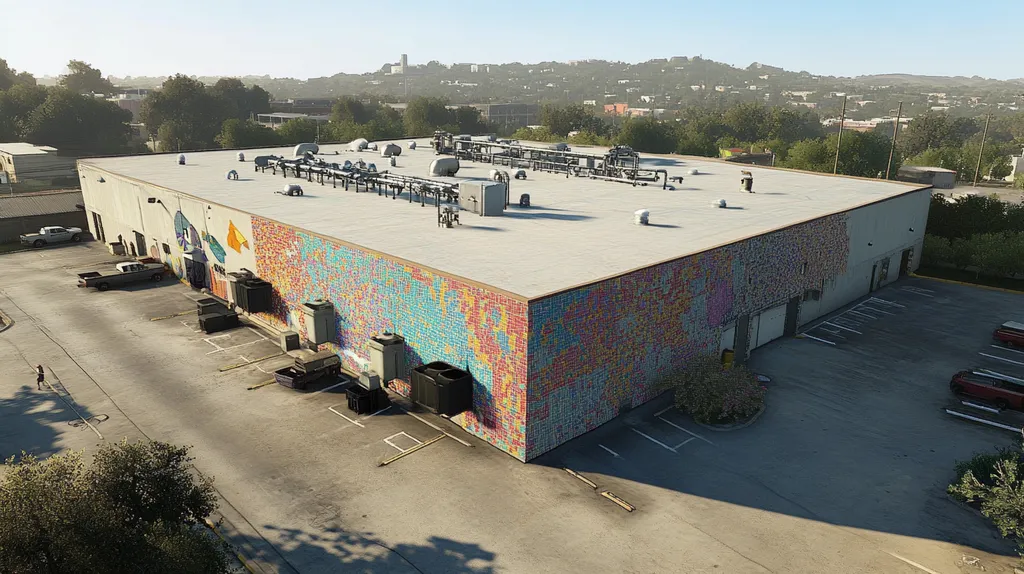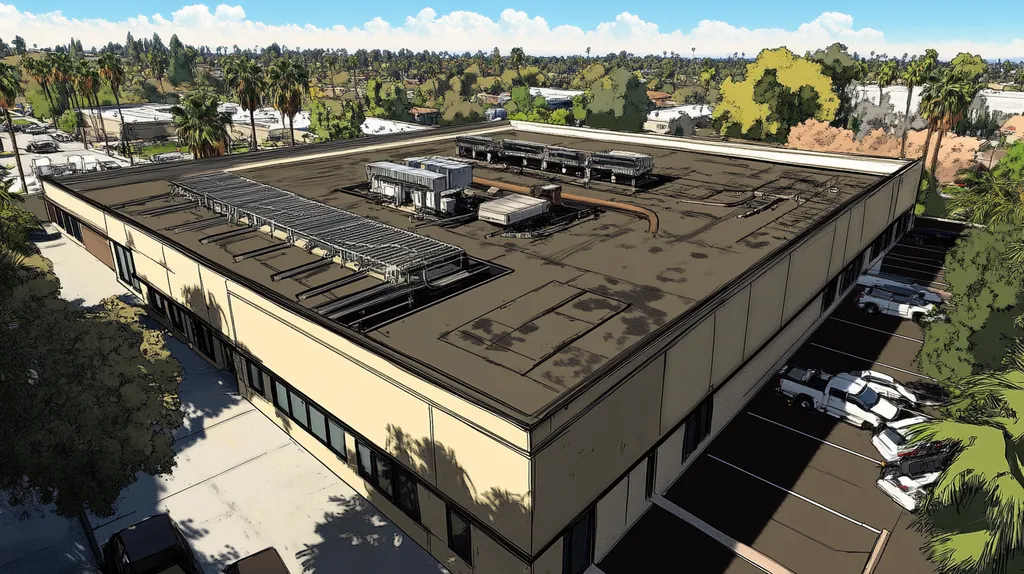Welcome to today’s Battle Royale featuring two roofing heavyweights: “Roof Inspection Tools” in the east corner versus “Drone Inspections” in the west!
Tonight’s showdown pits these contenders against each other across six punishing rounds designed to test every aspect of their performance for Industrial Roof Coating Inspection.
At stake? Millions in potential costs, decades of building protection, and the critical performance demands of modern commercial and industrial facilities.
Our professional judging panel will evaluate each round on technical merit, real-world performance, and value delivery. After all six rounds, we’ll declare our ultimate champion.
Ladies and gentlemen, facility managers and building owners… it’s time to rumble!
ROUND 1: INITIAL COSTS & INSTALLATION
In today’s demanding industrial environment, proper roof coating inspections can mean the difference between a long-lasting protective barrier and premature system failure. With coating failures potentially leading to hundreds of thousands in repair costs and business disruption, choosing the right inspection method is crucial for facility managers and building owners.
Material Expenses
Traditional inspection tools represent a modest initial investment, typically ranging from basic moisture meters to thermal scanners. These tools require regular calibration and occasional replacement, but their individual costs remain relatively low.
Drone systems demand a significant upfront investment, including the aircraft, sensors, software licenses, and operator training. However, these systems can inspect larger areas more thoroughly while requiring fewer support equipment purchases like scaffolding or lifts.
While drones have higher initial costs, their superior detection capabilities and reduced need for supplementary equipment provide better value over time. In this category, “ADVANTAGE: Traditional Tools” due to lower barrier to entry.
Installation Complexity
Traditional inspection methods require extensive setup time and safety equipment. Each inspection area needs proper staging, fall protection systems, and multiple access points, creating logistical challenges for large facilities.
Drone inspections eliminate most physical setup requirements, needing only a clear takeoff area and proper flight planning. One trained operator can typically manage the entire inspection process with minimal support equipment.
The reduced complexity of drone operations translates to fewer coordination requirements and simpler execution. For this reason, “ADVANTAGE: Drone Inspections” in terms of setup and deployment simplicity.
Project Timeline
Manual inspections with traditional tools are inherently time-consuming. Technicians must physically access each roof section, carefully document findings, and often return multiple times to verify conditions.
Drones can capture comprehensive roof data in a fraction of the time required for manual inspections. A typical 50,000-square-foot roof that takes days to inspect manually can be surveyed by drone in hours.
The dramatic reduction in inspection time allows coating projects to begin sooner and proceed more efficiently. For timeline efficiency, “ADVANTAGE: Drone Inspections” is clear and significant.
ROUND 1 WINNER: Drone Inspections
ROUND 2: DURABILITY & LIFESPAN
When it comes to industrial roof coatings, inspection quality directly impacts system longevity. Failed coatings can lead to extensive water damage, structural issues, and costly business interruptions. The choice between traditional inspection tools and drone technology can mean the difference between a roof lasting 20+ years or failing prematurely.
Equipment Resilience
Traditional inspection tools like moisture meters and thermal scanners are built to withstand harsh rooftop conditions. These devices typically maintain accuracy for 3-5 years with proper maintenance and calibration, though their effectiveness depends heavily on operator skill.
Drones face unique durability challenges, including motor wear, battery degradation, and sensitive electronic components. However, commercial-grade inspection drones now feature weatherproof designs, redundant systems, and field-serviceable parts that extend their operational life.
While both systems require regular maintenance, traditional tools demonstrate superior long-term durability in challenging industrial environments. ADVANTAGE: Traditional Tools.
Data Reliability Over Time
Traditional inspection methods rely heavily on individual technician expertise and interpretation. This subjective approach can lead to inconsistent results between inspections and make tracking changes over time difficult.
Drone systems capture standardized, high-resolution imagery and sensor data that remains consistent regardless of operator. This digital documentation creates reliable historical records for comparing roof conditions across multiple inspections.
The objective, repeatable nature of drone-collected data provides superior tracking of coating performance and degradation patterns. ADVANTAGE: Drone Inspections.
Maintenance Requirements
Basic inspection tools need minimal maintenance beyond regular calibration and battery replacement. Most issues can be addressed quickly on-site without specialized technical knowledge.
Drone systems require more intensive maintenance schedules, including motor servicing, sensor calibration, and software updates. However, this maintenance can be performed off-site without disrupting inspection schedules.
While drones demand more complex maintenance, their superior data collection capabilities outweigh these additional requirements. ADVANTAGE: Drone Inspections.
ROUND 2 WINNER: Drone Inspections
ROUND 3: PERFORMANCE FACTORS
When industrial roof coatings fail due to inadequate inspections, the consequences can be devastating – from structural damage to operational shutdowns. Every year, facilities waste millions on premature roof replacements that could have been prevented through better inspection practices. As coating technology advances, the methods we use to inspect and verify roof conditions must evolve to meet these new challenges.
Effectiveness in Identifying Issues
Regular inspections and proper maintenance are crucial for preventing costly repairs and maximizing roof longevity. Traditional tools like moisture meters and infrared scanners can detect basic issues but often struggle with hard-to-reach areas and complex roofing systems. (source: GreenStar Coatings)
Drone inspections utilize advanced imaging technology to capture comprehensive data from every angle. Their ability to access difficult spots and generate detailed thermal maps provides unprecedented insight into coating conditions and potential failure points.
While traditional tools remain useful for spot checks, drones offer superior coverage and detection capabilities for large industrial facilities. ADVANTAGE: Drone Inspections.
Time Efficiency During Inspections
Traditional inspection methods require careful setup and methodical coverage of the roof surface. Technicians must physically access each section, taking detailed notes and photos while ensuring their safety equipment remains properly secured.
Drone systems can survey extensive roof areas in a fraction of the time needed for manual inspections. A single flight can capture detailed imagery of an entire facility, allowing for immediate analysis and quick identification of problem areas.
The dramatic reduction in inspection time and improved safety make drones the clear winner for efficiency. ADVANTAGE: Drone Inspections.
Data Quality and Usability
Traditional inspection tools provide reliable point-source data but struggle with comprehensive documentation. Manual measurements and observations can vary between technicians, making it difficult to track changes over time.
Drone technology delivers consistent, high-resolution imagery and precise measurements across multiple inspection cycles. The digital format allows for easy comparison, analysis, and sharing of data among stakeholders.
The superior data collection and standardization capabilities of drone systems make them the obvious choice for modern facilities. ADVANTAGE: Drone Inspections.
ROUND 3 WINNER: Drone Inspections
ROUND 4: MAINTENANCE REQUIREMENTS
In the high-stakes world of industrial roofing, proper maintenance can mean the difference between a 30-year roof and catastrophic failure within 5 years. Every inspection decision impacts not just the immediate condition assessment, but the long-term maintenance strategy and ultimately the roof’s lifespan. With coating failures often resulting in six-figure repair costs, choosing the right inspection approach is crucial for protecting these valuable assets.
Regular Inspection Requirements
Before any coating application, thorough inspection of roof flashings, fixture sealants, and mounting hardware is essential for identifying potential failure points. These critical components often determine whether a coating system will perform as intended or fail prematurely. (source: Giromax Technology)
Traditional inspection methods require extensive physical access to examine these areas up close. Teams must carefully document each finding while navigating safety requirements and weather constraints, often extending the inspection timeline.
Drone systems can rapidly assess these same components from multiple angles, creating detailed visual records without placing personnel at risk. The speed and comprehensiveness of drone inspections allow for more frequent monitoring of critical areas.
Given the superior coverage and reduced safety risks, ADVANTAGE: Drone Inspections.
Documentation and Record-Keeping
Traditional inspection tools generate paper-based or basic digital records that must be manually organized and archived. This documentation process is time-consuming and can lead to inconsistencies between different inspectors or inspection periods.
The standardized data collection of drone systems creates instantly shareable digital records with precise measurement data. These comprehensive records make it easier to track changes over time and predict maintenance needs.
Digital documentation from drones enables better historical tracking and more accurate maintenance forecasting. ADVANTAGE: Drone Inspections.
Ongoing Monitoring Requirements
Traditional inspection methods typically require quarterly or semi-annual comprehensive reviews, with spot checks between major inspections. This schedule often misses developing issues in hard-to-reach areas.
Drone systems enable more frequent inspections with minimal disruption to facility operations. Regular monitoring can catch potential problems before they develop into serious issues requiring extensive repairs.
The ability to conduct more frequent, thorough inspections with less operational impact gives drones a clear edge. ADVANTAGE: Drone Inspections.
ROUND 4 WINNER: Drone Inspections
ROUND 5: SUSTAINABILITY CREDENTIALS
As industrial facilities face mounting pressure to reduce their environmental impact, the sustainability of roof inspection methods has become a critical decision point. With new environmental regulations emerging yearly and stakeholders demanding greener operations, choosing between traditional tools and drone technology can significantly impact a facility’s ecological footprint and compliance status.
Environmental Impact of Inspection Methods
Traditional roof inspections require extensive equipment transportation, often involving multiple vehicles and heavy machinery. The carbon footprint extends beyond just transportation, as these methods frequently demand generators and fuel-powered lifts for extended periods.
Manual inspection processes also create significant material waste through disposable safety equipment and temporary structures. The environmental cost multiplies when considering the frequency of inspections needed for proper coating maintenance.
Drone inspections operate primarily on rechargeable batteries and require minimal support equipment. A single operator can complete comprehensive surveys without the need for fuel-consuming machinery or disposable materials.
The dramatic reduction in carbon emissions and material waste makes drones the clear environmental champion. ADVANTAGE: Drone Inspections.
Resource Efficiency and Waste Management
Traditional inspection methods consume significant resources through equipment wear, replacement parts, and disposable materials. Each inspection cycle requires new safety equipment and generates waste that often cannot be recycled.
The physical nature of manual inspections also increases the risk of damage to existing roof materials. This damage frequently leads to premature replacement and additional material waste.
Drone technology minimizes resource consumption by eliminating most physical contact with the roof surface. The primary resources needed are electricity for charging and occasional component updates.
With substantially lower resource requirements and minimal waste generation, drones demonstrate superior efficiency. ADVANTAGE: Drone Inspections.
Compliance with Sustainability Standards
Traditional inspection methods struggle to meet evolving environmental regulations. Their reliance on fossil fuels and disposable materials increasingly conflicts with corporate sustainability targets and government mandates.
Many facilities find traditional methods make it difficult to achieve green building certifications. The inability to demonstrate sustainable practices can impact property values and tenant relationships.
Drone inspections align naturally with sustainability frameworks, offering documented reduction in environmental impact. Their digital documentation also simplifies reporting for environmental compliance and certification programs.
The superior alignment with sustainability standards and easier compliance reporting gives drones a clear edge. ADVANTAGE: Drone Inspections.
ROUND 5 WINNER: DRONE INSPECTIONS
ROUND 6: SPECIALIZED APPLICATIONS
Industrial roof coatings represent a critical investment, with specialized application challenges that can make or break long-term performance. Recent industry data shows that inadequate pre-coating inspections lead to 45% of premature coating failures, costing facilities an average of $380,000 in emergency repairs. For building owners and facility managers, choosing the right inspection method for these specialized scenarios isn’t just about efficiency – it’s about protecting massive investments.
Assessing Complex Roof Features
Before applying coatings, thorough inspection of roof flashings, fixture sealants, and mounting hardware is essential for identifying potential failure points. These critical components often determine whether a coating system will perform as intended or fail prematurely. (source: Giromax Technology)
Traditional inspection methods require technicians to physically examine each component up close. This process is time-consuming and often restricted by safety limitations, particularly around edges and elevation changes.
Drone systems can rapidly capture detailed imagery of complex features from multiple angles. Their advanced sensors can detect subtle issues in hard-to-reach areas that might compromise coating adhesion.
For thorough assessment of complex features, ADVANTAGE: Drone Inspections.
Environmental Condition Analysis
Industrial environments present unique challenges for coating applications, from chemical exposure to extreme temperature variations. Traditional inspection tools provide limited data about these environmental factors, often missing subtle conditions that could affect coating performance.
Manual inspections typically rely on spot checks and visual assessments, which may not capture the full scope of environmental impacts across large roof areas. This limitation can lead to coating failures in areas where environmental stresses weren’t properly identified.
Drones equipped with specialized sensors can map temperature variations, detect chemical residues, and identify areas of moisture accumulation. This comprehensive environmental data helps ensure coating specifications match actual roof conditions.
Given the superior environmental analysis capabilities, ADVANTAGE: Drone Inspections.
Coating Compatibility Verification
Ensuring proper adhesion between existing roof surfaces and new coatings requires detailed surface analysis. Traditional inspection methods rely heavily on destructive testing and limited sample areas, which may not represent overall roof conditions.
Manual testing methods can damage existing surfaces and provide incomplete data about substrate conditions. This limitation often leads to coating failures in areas where incompatibilities weren’t detected.
Drone systems using multispectral imaging can identify surface variations, contamination, and other factors affecting coating compatibility across the entire roof. This comprehensive analysis helps prevent coating failures due to overlooked surface conditions.
For thorough compatibility assessment, ADVANTAGE: Drone Inspections.
ROUND 6 WINNER: DRONE INSPECTIONS
AND THE WINNER IS…
After six grueling rounds of technical evaluation, we have our verdict…
In a stunning display of technological dominance, DRONE INSPECTIONS claims the championship belt with a decisive 6-0 victory! This wasn’t just a win – it was a complete technical knockout.
Drone technology dominated through superior detection capabilities, dramatic time savings, and unprecedented data collection abilities. From sustainability credentials to specialized applications, drones proved they’re the future of industrial roof coating inspections.
But don’t count traditional tools out completely! In situations requiring detailed spot inspections or when working with limited budgets, these tried-and-true veterans still bring valuable capabilities to the ring.
IMPORTANT NOTICE: Every facility faces unique challenges that can impact inspection method effectiveness. Local regulations, building characteristics, and specific coating requirements must all factor into your decision. This analysis provides general guidance but cannot account for all variables. Always consult qualified roofing professionals who can evaluate your specific situation.
Ladies and gentlemen, the future of industrial roof inspections has arrived! But remember – in the high-stakes arena of roof coating performance, the real victory comes from matching your facility’s unique requirements with the right inspection champion in your corner.
FREQUENTLY ASKED QUESTIONS
Q. What are the initial costs of commercial roof inspections?
A. Traditional inspection tools often have lower initial costs due to their affordable prices. However, drones require a significant upfront investment for their advanced technology. That said, drones can save you money in the long run by reducing repairs caused by undetected issues.
Q. How does inspection quality affect industrial roof lifespan?
A. The quality of inspections is crucial for prolonging roof longevity. Poor inspections can lead to coating failures, causing water damage and costly repairs. Investing in thorough inspections ensures that potential issues are detected early, maximizing the roof’s lifespan.
Q. Are drone inspections more efficient than traditional methods?
A. Yes, drone inspections are significantly more efficient compared to traditional methods. Drones can cover large areas in a fraction of the time, reducing overall inspection duration. This efficiency can lead to faster decision-making for coating applications and maintenance planning.
Q. How do drone inspections improve data reliability for commercial roofs?
A. Drone inspections capture standardized, high-resolution data that reduces variability caused by human error. This level of objectivity allows for better tracking of roof conditions over time, leading to more reliable maintenance strategies and informed decisions regarding coatings.
Q. What are the sustainability benefits of using drones for roof inspections?
A. Using drones for inspections greatly reduces carbon emissions and waste. Traditional methods require significant fuel and materials, while drones primarily operate on rechargeable batteries. This eco-friendly approach aligns with growing sustainability goals for many industrial facilities.
Q. How can drones assist in specialized roof applications?
A. Drones excel in assessing complex roof features that are hard to reach manually. Their advanced imaging capabilities allow for thorough inspections of critical areas like flashings and sealants. This data is essential for ensuring that coatings adhere properly and perform as intended.
Q. How often should commercial roofs be inspected before recoating?
A. Regular inspections should be conducted semi-annually or more frequently if needed. Pre-coating inspections are particularly essential as they identify potential issues that could affect coating performance. Integrating drone inspections can enhance the frequency and thoroughness of these evaluations.

